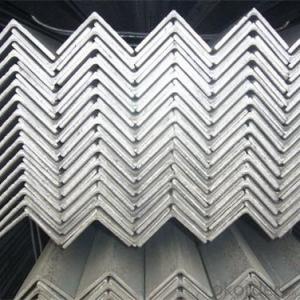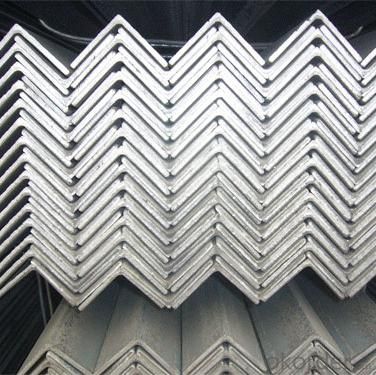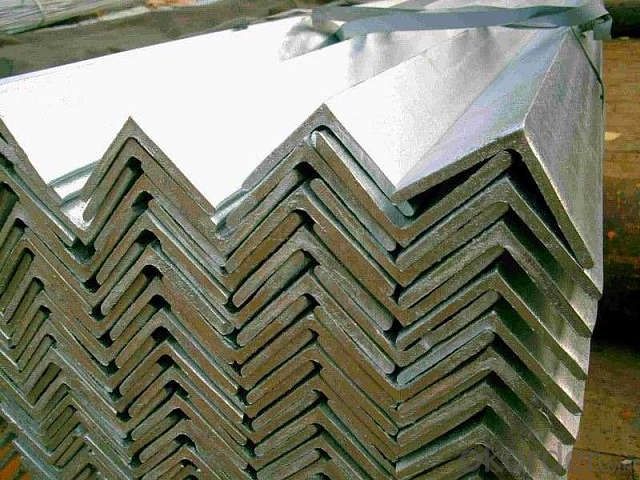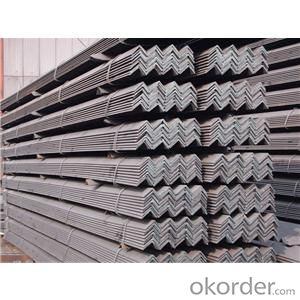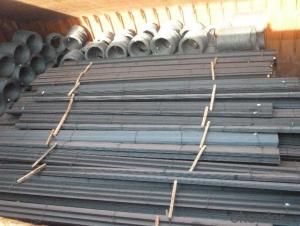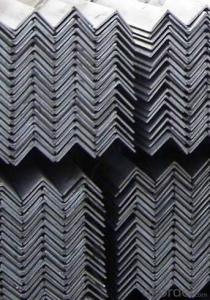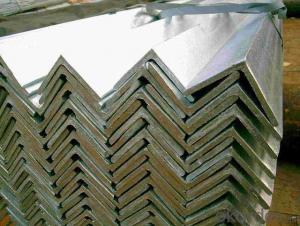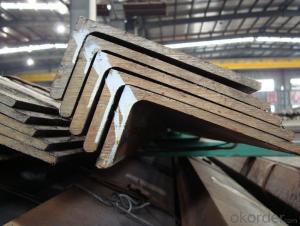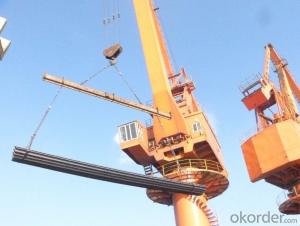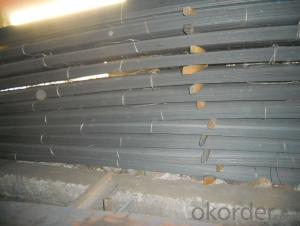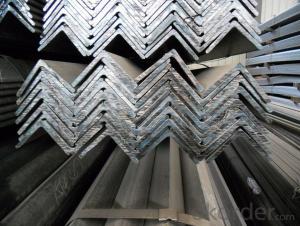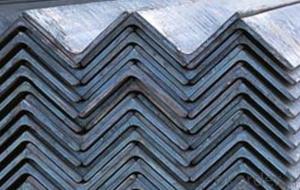Hot Rolled Equilateral Small Angle Steel
- Loading Port:
- Tianjin
- Payment Terms:
- TT or LC
- Min Order Qty:
- 25 m.t.
- Supply Capability:
- 2000 m.t./month
OKorder Service Pledge
OKorder Financial Service
You Might Also Like
Product Description:
OKorder is offering Hot Rolled Equilateral Small Angle Steel at great prices with worldwide shipping. Our supplier is a world-class manufacturer of steel, with our products utilized the world over. OKorder annually supplies products to European, North American and Asian markets. We provide quotations within 24 hours of receiving an inquiry and guarantee competitive prices.
Product Applications:
Hot Rolled Equilateral Small Angle Steel are ideal for structural applications and are widely used in the construction of buildings and bridges, and the manufacturing, petrochemical, and transportation industries.
Product Advantages:
OKorder's Hot Rolled Equilateral Small Angle Steel are durable, strong, and resist corrosion.
Main Product Features:
· Premium quality
· Prompt delivery & seaworthy packing (30 days after receiving deposit)
· Corrosion resistance
· Can be recycled and reused
· Mill test certification
· Professional Service
· Competitive pricing
Product Specifications:
Manufacture: Hot rolled
Grade: Q195 – 235
Certificates: ISO, SGS, BV, CIQ
Length: 6m – 12m, as per customer request
Packaging: Export packing, nude packing, bundled
Chinese Standard (H*W*T) | Weight (Kg/m) | 6m (pcs/ton) | Light I (H*W*T) | Weight (Kg/m) | 6m (pcs/ton) | Light II (H*W*T) | Weight (Kg/m) | 6M |
100*68*4.5 | 11.261 | 14.8 | 100*66*4.3 | 10.13 | 16.4 | 100*64*4 | 8.45 | 19.7 |
120*74*5.0 | 13.987 | 11.9 | 120*72*4.8 | 12.59 | 13.2 | 120*70*4.5 | 10.49 | 15.8 |
140*80*5.5 | 16.89 | 9.8 | 140*78*5.3 | 15.2 | 10.9 | 140*76*5 | 12.67 | 13.1 |
160*88*6 | 20.513 | 8.1 | 160*86*5.8 | 18.46 | 9 | 160*84*5.5 | 15.38 | 10.8 |
180*94*6.5 | 24.143 | 6.9 | 180*92*6.3 | 21.73 | 7.6 | 180*90*6 | 18.11 | 9.2 |
200*100*7 | 27.929 | 5.9 | 200*98*6.8 | 25.14 | 6.6 | 200*96*6.5 | 20.95 | 7.9 |
220*110*7.5 | 33.07 | 5 | 220*108*7.3 | 29.76 | 5.6 | 220*106*7 | 24.8 | 6.7 |
250*116*8 | 38.105 | 4.3 | 250*114*7.8 | 34.29 | 4.8 | 250*112*7.5 | 28.58 | 5.8 |
280*122*8.5 | 43.492 | 3.8 | 280*120*8.2 | 39.14 | 4.2 | 280*120*8 | 36.97 | 4.5 |
300*126*9 | 48.084 | 3.4 | 300*124*9.2 | 43.28 | 3.8 | 300*124*8.5 | 40.87 | 4 |
320*130*9.5 | 52.717 | 3.1 | 320*127*9.2 | 48.5 | 3.4 | |||
360*136*10 | 60.037 | 2.7 | 360*132*9.5 | 55.23 | 3 |
FAQ:
Q1: Why buy Materials & Equipment from OKorder.com?
A1: All products offered byOKorder.com are carefully selected from China's most reliable manufacturing enterprises. Through its ISO certifications, OKorder.com adheres to the highest standards and a commitment to supply chain safety and customer satisfaction.
Q2: How do we guarantee the quality of our products?
A2: We have established an advanced quality management system which conducts strict quality tests at every step, from raw materials to the final product. At the same time, we provide extensive follow-up service assurances as required.
Q3: How soon can we receive the product after purchase?
A3: Within three days of placing an order, we will begin production. The specific shipping date is dependent upon international and government factors, but is typically 7 to 10 workdays.
Q4: What makes stainless steel stainless?
A4: Stainless steel must contain at least 10.5 % chromium. It is this element that reacts with the oxygen in the air to form a complex chrome-oxide surface layer that is invisible but strong enough to prevent further oxygen from "staining" (rusting) the surface. Higher levels of chromium and the addition of other alloying elements such as nickel and molybdenum enhance this surface layer and improve the corrosion resistance of the stainless material.
Q5: Can stainless steel rust?
A5: Stainless does not "rust" as you think of regular steel rusting with a red oxide on the surface that flakes off. If you see red rust it is probably due to some iron particles that have contaminated the surface of the stainless steel and it is these iron particles that are rusting. Look at the source of the rusting and see if you can remove it from the surface.
Images:
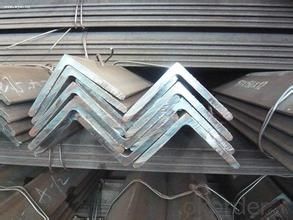


- Q: Unequal angle steel
- Unequal angle steel: in the field of engineering materials, relative to two equal side length equal angles, refers to the section of the right angle, L shaped, and unequal length of both sides of the angle. It is widely used in engineering structure, structure and variety of municipal public utilities, civil and military industries, such as industrial beams, bridges, towers, hoisting and conveying machinery, ships, industrial furnace, reaction tower, container frame, and warehouses, because the amount is less than the unilateral angle, so the relative price slightly higher.
- Q: Can steel angles be used as framing members for suspended ceilings?
- Yes, steel angles can be used as framing members for suspended ceilings. They provide structural support and stability to hold the ceiling tiles or panels in place.
- Q: How are steel angles manufactured?
- Steel angles are typically manufactured through a process known as hot rolling. This involves heating a steel billet or slab to a high temperature and then passing it through a series of rollers to shape it into the desired angle profile. The rollers have specially designed grooves that give the steel its distinctive L-shaped cross-section. During the hot rolling process, the steel is subjected to high pressure and strain, which helps to shape and form it. The heated steel is passed through the rollers multiple times to achieve the desired dimensions and surface finish. This process also helps to remove any impurities and improve the overall quality of the steel. Once the steel angles are formed, they are then cooled down, either by air or water, to stabilize their shape. After cooling, the angles may undergo further processing such as straightening, cutting to length, drilling holes, or adding other features as per the specific requirements. It is worth mentioning that steel angles can also be manufactured through a cold rolling process. In this method, the steel is not heated, but instead, it is passed through rollers at room temperature. Cold-rolled angles tend to have a smoother surface finish and tighter dimensional tolerances. Overall, the manufacturing of steel angles involves a combination of heating, rolling, and cooling processes to shape the steel into the desired angle profile. This process ensures that the angles are strong, durable, and suitable for various applications in construction, manufacturing, and other industries.
- Q: What are the different types of steel angles connections for joists?
- There are several different types of steel angle connections commonly used for joists. These include: 1. Welded Connection: This is the most common and simplest type of connection, where the steel angles are welded directly to the joists. It provides a strong and rigid connection, but it may require skilled labor and additional time for welding. 2. Bolted Connection: In this type of connection, the steel angles are bolted to the joists using bolts or screws. This allows for easier installation and disassembly if needed. However, it may not be as strong as a welded connection and may require periodic tightening of the bolts. 3. Gusset Plate Connection: A gusset plate is a flat steel plate that is used to connect the steel angles to the joists. It is usually welded or bolted to both the angles and the joists, providing additional strength and stability to the connection. 4. Clip Angle Connection: Clip angles are L-shaped brackets that are attached to the joists and steel angles using bolts or screws. They provide a simple and effective means of connecting the angles to the joists, and can be easily adjusted or replaced if necessary. 5. Shear Plate Connection: This type of connection involves using a shear plate, which is a thick steel plate with holes, to connect the steel angles to the joists. The shear plate is typically welded or bolted to both the angles and the joists, providing a strong and secure connection. Each type of steel angle connection has its own advantages and disadvantages, so the choice of connection method will depend on factors such as the load requirements, ease of installation, and cost considerations.
- Q: How do you transport and ship steel angles?
- Steel angles can be transported and shipped using various methods, depending on their size and quantity. Typically, smaller steel angles can be bundled and packed onto pallets or in crates, which are then loaded onto trucks or shipping containers for transportation. For larger and heavier steel angles, specialized equipment such as flatbed trucks or trailers with cranes may be required. Additionally, steel angles can also be shipped in bulk, either loose or in coils, using bulk carriers or barges. It is important to ensure proper packaging, securing, and labeling to ensure safe and efficient transportation and shipping of steel angles.
- Q: Are steel angles resistant to impact or vibration?
- Steel angles are known for their high strength and durability, making them generally resistant to impact and vibration. However, the specific resistance to these forces would depend on various factors such as the thickness and quality of the steel, as well as the magnitude and frequency of the impact or vibration.
- Q: Can steel angles be used for agricultural buildings or barns?
- Indeed, agricultural buildings or barns can employ steel angles. The prevailing usage of steel angles in construction is attributed to their robustness and endurance. Specifically, they prove invaluable in agricultural buildings or barns, where the structure must endure substantial burdens and adverse weather conditions. Steel angles can be employed in the framing, bracing, and reinforcement of diverse building constituents, including walls, roofs, and doors. Furthermore, steel angles can be readily fabricated and tailored to fulfill precise design specifications, rendering them a multifaceted option for agricultural buildings or barns.
- Q: Can steel angles be used in industrial or heavy-duty applications?
- Absolutely, steel angles are a perfect fit for industrial or heavy-duty uses. Renowned for their robustness, endurance, and flexibility, steel angles are highly versatile and find application across a wide range of industries. They play a vital role in providing structural reinforcement, support, and stability to heavy-duty machinery, equipment, and infrastructure projects. Construction, manufacturing, engineering, transportation, and various other industries commonly employ steel angles. Their usage spans frames, supports, bracings, platforms, beams, and trusses, where strength and load-bearing capacity are paramount. Moreover, steel angles can withstand extreme temperatures, harsh weather conditions, and heavy loads, making them ideal for demanding industrial environments. In summary, steel angles are a dependable and efficient choice for industrial or heavy-duty applications, thanks to their strength, durability, and adaptability.
- Q: Are steel angles resistant to vibrations?
- Yes, steel angles are generally resistant to vibrations due to their rigid and sturdy structure. The inherent strength and stability of steel make it a suitable material for withstanding vibrations caused by various sources.
- Q: What is angle iron?
- Angle called angle, the steel strip is perpendicular to each other on both sides into the corner.
Send your message to us
Hot Rolled Equilateral Small Angle Steel
- Loading Port:
- Tianjin
- Payment Terms:
- TT or LC
- Min Order Qty:
- 25 m.t.
- Supply Capability:
- 2000 m.t./month
OKorder Service Pledge
OKorder Financial Service
Similar products
Hot products
Hot Searches
Related keywords
